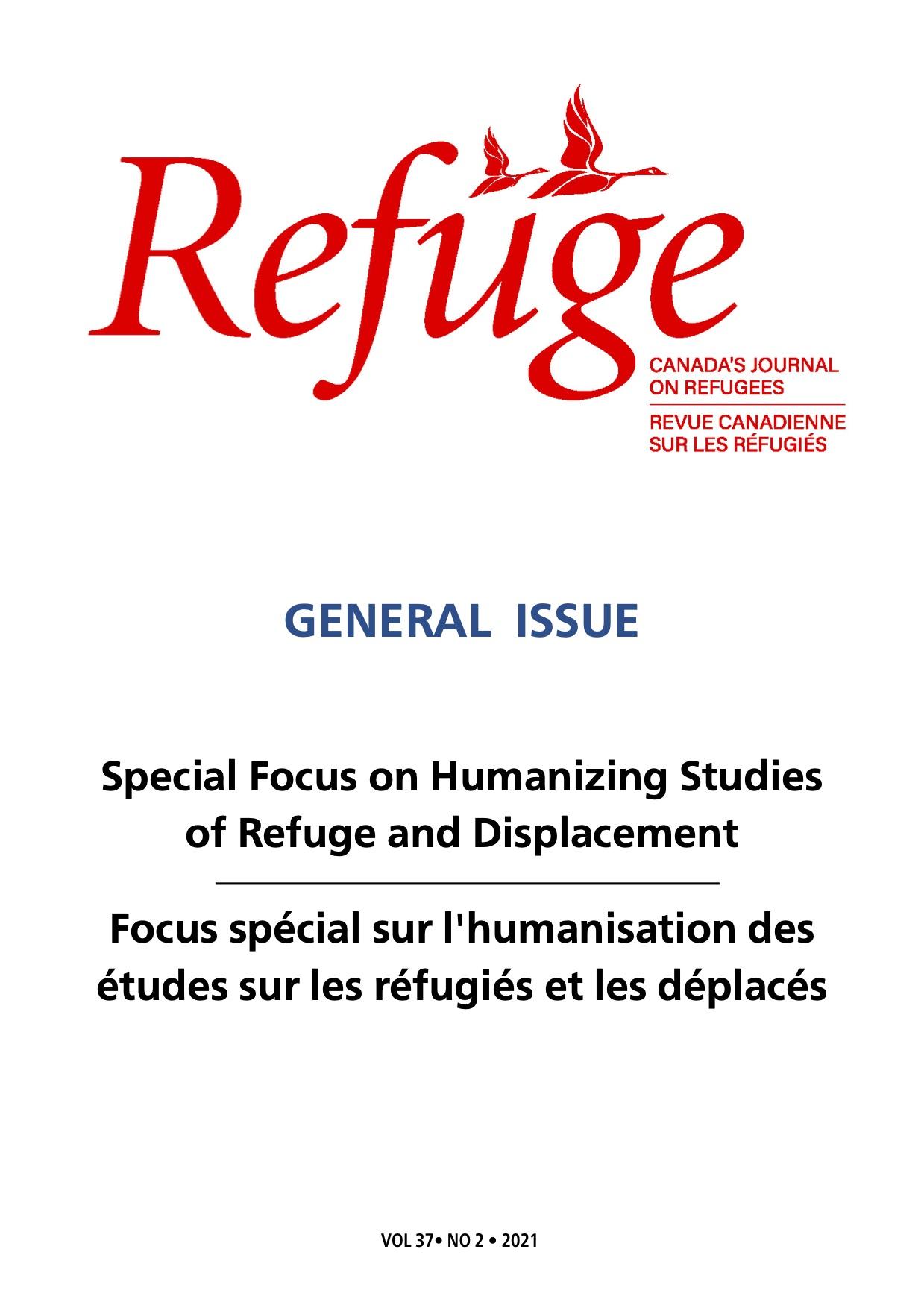Résumés
Abstract
In this intervention, I reflect on what it may mean to ‘humanize’ refugee research. The assumption often made is that ‘humanizing’ can arise through a concern with the particularity of the individual, through drawing from ‘the mass’ the narrative of the singular and employing this as a means to identify, , and potentially understand others. Yet such a move risks a reliance on creating relations of empathy and compassion that elide political responses to dehumanization and often relies on a assumption of what constitutes the category of “the human,” an assumption that has been critically challenged by post-colonial writing.
Keywords:
- humanization,
- refugee studies,
- refugee mobility,
- race
Résumé
Dans cette intervention, je réfléchis à ce que pourrait signifier d’ la recherche sur les réfugiés. On suppose souvent que l’humanisation» peutémerger à travers une attention à la particularité de l’individu, en puisant dans la le récit singulier et en utilisant ceci comme moyen de s’identifier, de compatir et potentiellement de comprendre les autres. Cependant, par un tel geste on court le risque de miser sur le recours à la création de relations d’empathie et de compassion qui passe outre à une réponse politique à la déshumanisation et qui repose sur une présomption universaliste de ce qui constitue la catégorie de l’, présomption qui a été remise en question par les écrits postcoloniaux.
Parties annexes
Bibliography
- Arendt, H. (1958). The origins of totalitarianism. Meridian.
- Bleiker, R., Campbell, D., Hutchison, E., & Nicholson, X. (2013). The visual dehumanisation of refugees. Australian Journal of Political Science, 48(4), 398–416. https://doi.org/10.1080/10361146.2013.840769
- Burrell, K., & Hörschelmann, K. (2019). Perilous journeys: Visualising the racialised “refugee crisis.” Antipode, 51(1), 45–65. https://doi.org/10.1111/anti.12429
- Collyer, M., & King, R. (2016). Narrating Europe’s migration and refugee “crisis.” Human Geography, 9(2), 1–12. https://doi.org/10.1177/194277861600900201
- Crawley, H. (2016). Managing the unmanageable? Understanding Europe’s response to the migration “crisis.” Human Geography, 9(2), 13–23. https://doi.org/10.1177/194277861600900202
- Crawley, H., & Skleparis, D. (2018). Refugees, migrants, neither, both: Categorical fetishism and the politics of bounding in Europe’s “migration crisis.” Journal of Ethnic and Migration Studies, 44(1), 48–64. https://doi.org/10.1080/1369183X.2017.1348224
- Darling, J. (2014). From hospitality to presence. Peace Review, 26(2), 162–169. https://doi.org/10.1080/10402659.2014.906872
- Darling, J. (2018). The fragility of welcome. Fennia, 196(2), 220–224. https://doi.org/10.11143/fennia.75756
- Dempsey, K. E., & McDowell, S. (2019). Disaster depictions and geopolitical representations in Europe’s migration “crisis.” Geoforum, 98(1), 153–160. https://doi.org/10.1177/194277861600900202
- El-Enany, N. (2016). Aylan Kurdi: The human refugee. Law Critique, 27(1), 13–15. https://doi.org/10.1007/s10978-015-9175-7
- Esposito, R. (2012). Third person. Polity Press.
- Forgiarini, M., Gallucci, M., & Malavita, A. (2011). Racism and the empathy for pain on our skin. Frontiers in Psychology, 2, Article 108. https://doi.org/10.3389/fpsyg.2011.00108
- George, R. (2018). Exile or refuge? Lights in the Distance overturns the spurious distinction. New Statesman. https://www.newstatesman.com/2018/05/daniel-trilling-lights-dark-exile-refuge-borders-europe-review
- Gill, N. (2016). Nothing personal? Geographies of governing and activism in the British asylum system. Wiley-Blackwell.
- Gill, N. (2018). The suppression of welcome. Fennia, 196(1), 88–98. https://doi.org/10.11143/fennia.70040
- Greussing, E., & Boomgaarden, H. G. (2017). Shifting the refugee narrative? An automated frame analysis of Europe’s 2015 refugee crisis. Journal of Ethnic and Migration Studies, 43(11), 1749–1774. https://doi.org/10.1080/1369183X.2017.1282813
- Hartley, L., & Fleay, C. (2017). “We are like animals”: Negotiating dehumanising experiences of asylum-seeker policies in the Australian community Refugee Survey Quarterly, 36(4), 45–63. https://doi.org/10.1093/rsq/hdx010
- Haslam, N. (2006). Dehumanization: An integrative review. Personality and Social Psychology Review, 10(3), 252–264. https://doi.org/10.1207/s15327957pspr1003_4
- Haslam, N., & Loughnan, S. (2014). Dehumanization and infrahumanization. Annual Review of Psychology, 65, 399–423. https://doi.org/10.1146/annurev-psych-010213-115045
- Ibrahim, Y., & Howarth, A. (2015). Sounds of the jungle: Rehumanizing the migrant. JOMEC Journal, 7, 1–19. https://doi.org/10.18573/j.2015.10008
- Jazeel, T. (2019). Singularity: A manifesto for incomparable geographies. Singapore Journal of Tropical Geography, 40(1), 5–21. https://doi.org/10.1111/sjtg.12265
- Jones, R. (2016). Violent borders: Refugees and the right to move. Verso.
- Kingsley, P. (2017). The new odyssey: The story of Europe’s refugee crisis. Faber & Faber.
- Kirkwood, S. (2017). The humanisation of refugees: A discourse analysis of UK parliamentary debates on the European refugee “crisis.” Journal of Community and Applied Social Psychology, 27(2), 115–125. https://doi.org/10.1002/casp.2298
- McDonald-Gibson, C. (2016). Cast away: Stories of survival from Europe’s refugee crisis. Portobello Books.
- Migrant Voice. (2014). Migration and the media. https://www.migrantvoice.org/design2020/img/upload/1._Migration-and-the-Media-2014_.pdf
- Nyers, P. (2006). Rethinking refugees: Beyond states of emergency. Routledge.
- Papastergiadis, N. (2009). Wog zombie: The de- and re-humanisation of migrants, from mad dogs to cyborgs. Cultural Studies Review, 15(2), 147–178. https://doi.org/10.5130/csr.v15i2.2043
- Sales, R. (2002). The deserving and the undeserving? Refugees, asylum seekers and welfare in Britain. Critical Social Policy, 22(3), 456–478. https://doi.org/10.1177/026101830202200305
- Smith, D. (2016) Refugee stories: Seven personal journeys behind the headlines. Instant Apostle.
- Smith, K., & Waite, L. (2019) New and enduring narratives of vulnerability: Rethinking stories about the figure of the refugee. Journal of Ethnic and Migration Studies, 45(13), 2289–2307. https://doi.org/10.1080/1369183X.2018.1496816
- Trilling, D. (2018). Lights in the distance: Exile and refuge at the borders of Europe. Picador.
- Weheliye, A G. (2014). Habeas viscus: Racializing assemblages, biopolitics, and black feminist theories of the human. Duke University Press.
- Wilson, H. F. (2014). The possibilities of tolerance: Intercultural dialogue in a multicultural Europe. Environment and Planning D: Society and Space, 32(5), 852–868. https://doi.org/10.1068/d13063p

